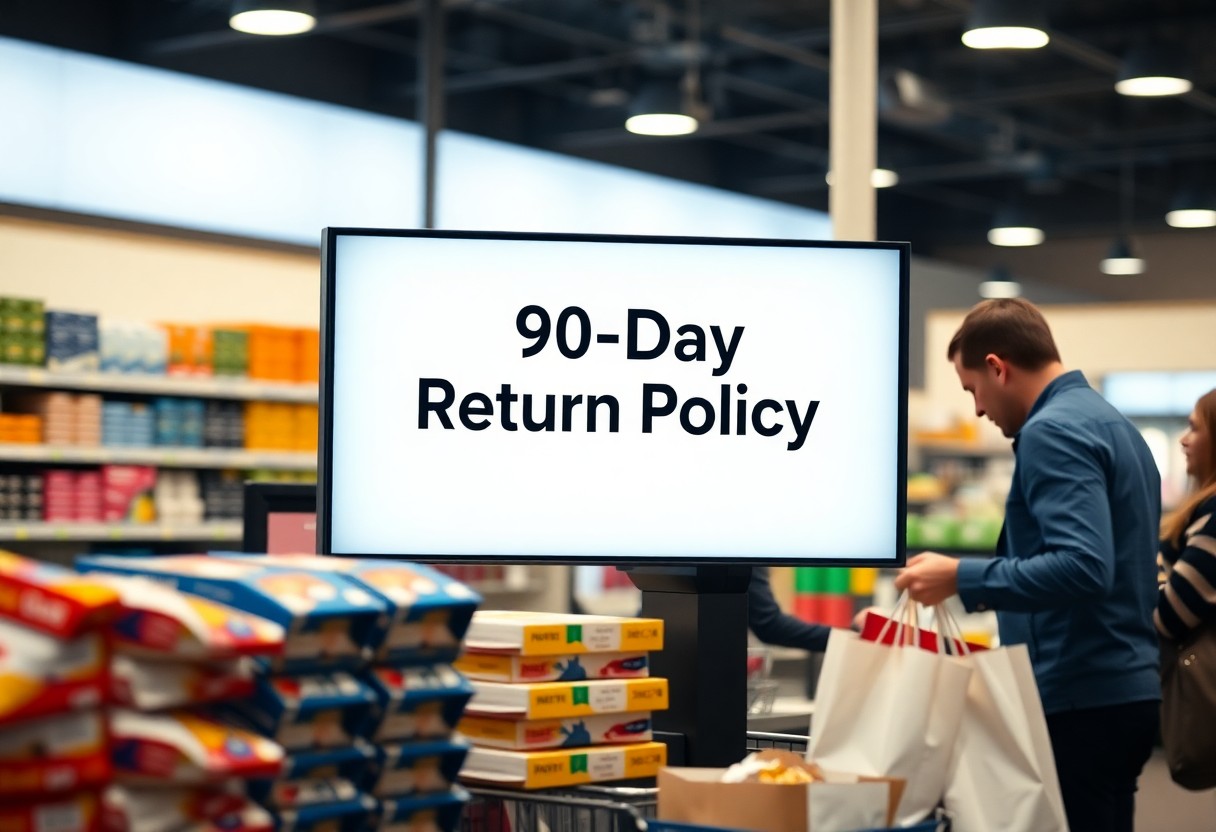Return policies can significantly impact your shopping experience. A 90-day return policy allows you ample time to assess your purchase, ensuring you are satisfied with your decision. This period offers you the flexibility to return items if they do not meet your expectations, minimizing your financial risk. However, be aware of specific conditions such as restocking fees or the requirement for the original packaging, as these can affect your ability to return products smoothly. Understanding the details of a 90-day return policy empowers you to shop with confidence.
Navigating the 90-Day Return Window
Key Features of a 90-Day Return Policy
A well-defined 90-day return policy includes several key features that enhance your shopping experience. The timeframe allows you to evaluate the product thoroughly, ensuring it meets your expectations. Key aspects often include:
- Extended Timeframe: You have a full 90 days from the date of purchase to initiate a return.
- Receipt Requirements: A receipt is typically necessary to process the return effectively.
- Condition of Items: Products should be in their original condition, including packaging, tags, or any accessories.
- Refund Options: You might have the choice between a full refund, store credit, or an exchange.
- Exceptions: Certain items might be excluded from the policy, such as opened electronics or personalized goods.
Thou stand to benefit significantly from understanding these features, as they can influence both your satisfaction and the practicality of returning unwanted items.
Timing Your Return: Best Practices
Acting promptly within the 90-day window can make the return process smoother. Ideally, you should initiate the return as soon as you determine an item does not meet your needs. Keeping track of your purchase date helps maintain awareness of your return deadline. Consider organizing your receipts and relevant email confirmations either digitally or in a dedicated spot to expedite returns.
Addressing the timing of your return involves not just the window but also considering factors like holiday seasons or sales events. During busy periods, processing times can extend, making it even more vital to return items at your earliest convenience. Engaging in these practices ensures you maximize the benefits of the 90-day return policy while minimizing potential inconveniences.
The Financial Implications of Extended Return Periods
The Impact on Retailer Revenue
Extending return periods to 90 days can significantly affect retailer revenue. On one hand, you may see an increase in sales as consumers feel more confident purchasing an item, knowing they have ample time to decide. Retailers often report up to a 20% increase in sales when implementing extended return policies. However, the flip side is the higher rate of returns. With a generous return period, your likelihood of returning items increases, which can create a burden on a retailer’s bottom line, especially if returns spike for popular categories.
Net revenue may be affected as retailers need to manage the cost of processing returns, including transportation and restocking. This can lead to challenges in cash flow management, and in some cases, you might find that retailers offset these costs by raising prices on merchandise. Case studies indicate that brands with lenient return policies have had to increase prices by as much as 10% on average to mitigate the financial fallout from higher return rates.
Cost-Benefit Analysis for Consumers
For you, the consumer, a 90-day return policy offers a significant advantage. It allows time for you to make considered decisions instead of rushed purchases, enabling you to assess product quality, fit, and overall satisfaction. The potential savings from avoiding buyer’s remorse can outweigh the short-term frustration of handling returns. You have more opportunities to test and evaluate items before finalizing your decision, effectively enhancing your shopping experience.
A deeper explore the cost-benefit analysis highlights that you can leverage extended return windows to secure the best deals. With clearance sales or seasonal discounts, purchasing when prices drop and returning later if the item doesn’t meet your expectations creates a safety net against potential losses. This strategic approach allows you to benefit financially while feeling empowered in your shopping choices.
Consumer Behavior: Psychology Behind Returns
Why Customers Prefer Longer Return Policies
Longer return policies, such as a 90-day window, create a sense of security for shoppers. This extended timeframe allows you to try out products in real-life situations, reducing the anxiety associated with making purchasing decisions. In fact, studies indicate that 67% of consumers prefer retailers with longer return policies, as they provide ample opportunity to determine whether an item truly fits your needs. You may find that a product looks great in the store but doesn’t quite work in your home or daily life.
Additionally, a generous return policy can enhance your overall shopping experience, fostering trust and loyalty toward the brand. Brands that offer longer return windows are often perceived as more customer-centric, which can positively influence your willingness to make a purchase. Many customers report that knowing they can return an item easily and without a strict timeframe makes them more likely to buy, especially for high-cost items like electronics or clothing.
The Influence of Return Policies on Purchase Decisions
Your decision to purchase is significantly influenced by the return policy in place. A return policy that promises a hassle-free return process enables you to feel more comfortable when purchasing items, knowing you have options if it doesn’t meet your expectations. For instance, research shows that almost 50% of online shoppers state they will abandon a cart if the return policy isn’t clearly defined or appears unfavorable. This hesitancy to purchase underlines the importance of making return policies accessible and clear.
Furthermore, brands with lenient return policies often see higher conversion rates and lower cart abandonment. You may also notice a greater tendency to try new products or impulse buys when confident in a favorable return policy. Retailers that effectively communicate their return policy details repeatedly see increases in customer satisfaction and repeat purchases.

Crafting a Customer-Friendly Return Experience
Streamlined Processes and Technology Integration
Implementing a seamless return process can drastically improve customer satisfaction. For instance, online retailers can benefit from automated return portals that allow you to initiate returns with just a few clicks. Using technology, brands can track return requests in real-time and provide instant updates on the status of your return, minimizing frustration. Additionally, utilizing logistics software can optimize reverse shipping, ensuring that you receive your refunds or exchanges promptly.
Integration of mobile apps can further enhance the return experience. Many companies now offer return labels that can be printed at home, eliminating the need for you to visit a physical store. Some retailers even partner with local drop-off points, allowing easy returns at convenient locations. This combination of technology and streamlined processes not only saves you time but also builds trust, as satisfaction with returns often translates into repeat purchases.
Communication Strategies for Effective Returns
Clear communication is key to a positive return experience. Service representatives should provide *personalized* assistance, ensuring you fully understand the return process and any conditions applicable. Transparency about timelines for refunds and exchanges helps set realistic expectations. Utilizing various channels—such as email, chat, and SMS—enables timely notifications and updates, keeping you informed throughout the return process.
Besides timely updates, incorporating FAQs and clear return guidelines on your website can significantly reduce confusion. This proactive approach helps you feel empowered and reassured about your decision to return an item. Leveraging customer feedback on your return process will also allow businesses to identify any gaps and continuously improve, ensuring that your experience is as smooth and straightforward as possible.

Beyond the Policy: Building Customer Trust
How a 90-Day Policy Enhances Brand Loyalty
A 90-day return policy can significantly strengthen your brand loyalty, as it conveys to customers that you stand by the quality of your products. This extended window encourages you to confidently make purchases without the fear of buyer’s remorse. Studies show that consumers are more likely to return to brands offering lenient return policies; they often cite ease of doing business and low perceived risk as key motivating factors. With a longer return period, you provide a space for customers to appreciate your products, which can lead to repeat purchases.
Additionally, a 90-day return policy nurtures a sense of transparency and reliability. When customers see that you trust them to return products within a generous timeframe, they are likely to feel valued. You create a positive feedback loop where purchasing becomes an enjoyable experience rather than a gamble. This can translate into greater customer retention rates and a stronger emotional connection to your brand.
Real-Life Examples of Successful Implementation
You can find many brands that have successfully implemented a 90-day return policy, which has positively impacted their business growth. For instance, retailer Zappos boasts a 365-day return policy, making it an industry leader in customer satisfaction. Customers feel empowered to try their products without immediate pressure, which results in loyal customers who advocate for the brand. Similarly, L.L. Bean’s famous return policy, allowing customers to return items at any time, has cultivated a loyal customer base, further enhancing trust in their brand.
Another example is Target, which has introduced a robust return program allowing 90 days for standard returns on most items. This policy boosts customer confidence, resulting in increased sales and loyalty. These companies illustrate how a well-structured return policy can foster trust and long-term consumer relationships, inviting customers to shop without hesitation.
To Wrap Up
With this in mind, a 90-day return policy provides you with ample time to evaluate your purchase and ensure it meets your expectations. This extended timeframe not only fosters confidence in your buying decisions but also allows you to address any issues that may arise post-purchase. By maintaining a clear understanding of the return policy, you can make purchases with reduced anxiety and the assurance that you have the flexibility to return items if necessary.
Your experience post-purchase is vital, and a 90-day return policy emphasizes the seller’s commitment to customer satisfaction. This policy empowers you to make informed choices and solidifies a trusting relationship with the retailer. Therefore, you should take full advantage of this period to assess your products and utilize the return option if needed, ultimately enhancing your overall shopping experience.
FAQ
Q: What items are eligible for the 90-day return policy?
A: Most items purchased through our store are eligible for return within 90 days, including clothing, electronics, and home goods. However, some products, such as personalized items or opened software, may be excluded from the return policy.
Q: How do I initiate a return under the 90-day policy?
A: To initiate a return, please visit our returns page on the website and follow the instructions provided. You will need your order number and details regarding the item(s) you wish to return. A return label will be generated for your convenience.
Q: Will I receive a full refund for items returned within the 90 days?
A: Yes, items returned within the 90-day window and in their original condition will qualify for a full refund. However, shipping costs are non-refundable, and potential restocking fees may apply depending on the item.